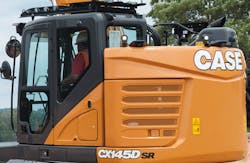Three Ways Data Leads to Coaching Opportunities
Machine data can help identify operator behaviors that can be changed quickly and easily through coaching, especially when the dealership carries the message. Three data points in particular, when analyzed, allow its dealers to let customers know how a change in behavior drives down cost and enhances productivity, according to Richie Snyder of Case Construction Equipment.
How to use telematics for operator and driver coaching
Snyder, marketing manager for telematics and machine control, said three utilization metrics—idle time, machine operation mode, and emissions—offer opportunities for equipment managers to guide operators. Equipment managers can view all of their Case machine data through a SiteWatch portal that the dealer will set up them.
“The best line of communications is the dealer being proactive and contacting that contractor and letting them know...about some of those coaching opportunities,” Snyder says. Case works with its dealerships to help them “own that relationship and be proactive in contacting and working with their customers.”
In regards to utilization, he says, “the biggest coaching opportunity is idle time. Can they shut the machine down so we’re not putting money out the tailpipe or accelerating warranty time?
“We have machines that are scattered across the county, the state, the country without the owner or fleet manager physically being there. They can drill down on idle time.”
Another coaching opportunity involves how the operator is running the machine, Snyder says.
“Are they running it full speed, all out, like a racetrack when they don’t need to be? Is that additional wear and tear on the undercarriage of the machine, higher engine temps, not to mention job site safety. If they should be traveling at 5 to 6 mph to be at a safe speed, and we’re noticing that they’re constantly driving at 20 or faster, that’s an unsafe work environment. Let’s drill into that before we create an unsafe environment.”
The third aspect of utilization relates to emissions technology. Data can help determine both if emissions systems are working properly, and if operators are running the regeneration cycle or if they are bypassing it, potentially harming the engine.
Each of these data points gives an equipment manager specific information that can lead to operator coaching opportunities, Snyder says.
The first thing a dealer can offer the customer is an understanding of what he expects the machine to do, what job they expect the machine to accomplish. “They can come up with a plan together to help monitor and have that line of communication,” he says.
“We need to have that dialogue right from the beginning, set up that expectation, as well as set up their profiles within our portal to make sure...we’re monitoring the right thing.”
The best way a dealer can guide coaching is by asking open-ended questions or self-guided questions, Snyder says. If the dealer can show an equipment manager how fuel consumption differs on two similar machines, for example, they can start a conversation.
“[We] rely on the dealership that has that personal connection with the operator. They go out and visit them at a sales point of view and at a service and parts point of view. They...know how to talk to that customer to explain the benefits of the machine. They can use that to coach that operator: ‘Maybe you can get more production if you change the setting’ or ‘Did you know that this machine has the capability of doing x, y, and z?’
“If you’re bringing value to the operator, they will stop and listen to you. Because if they can make the job easier, and they can be more productive, then they look a lot better to his bosses. The overall job and the overall company is being more productive and profitable.”
Snyder says Case dealers are looking to be more involved with their customers, not just from a maintenance viewpoint, but also from an operational one.
“Customers are buying machines today because of technology more so than for how much horsepower it has or what the drawbar pull is,” he says. “‘[H]ow is the machine going to do more for me, and last longer and be more productive.’”
The better an operator or equipment manager understands what to expect from their machine, the more they will understand not only the consequences of certain operator behaviors, but also the benefits.
